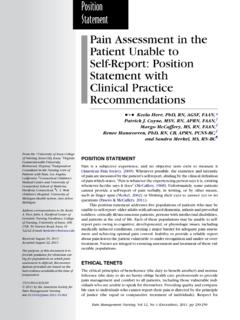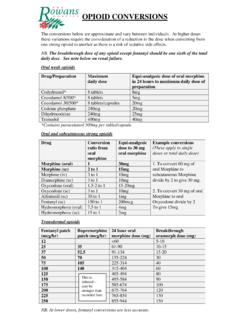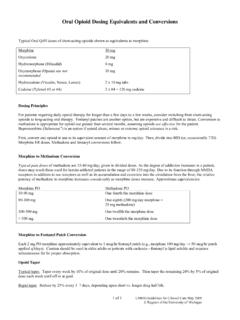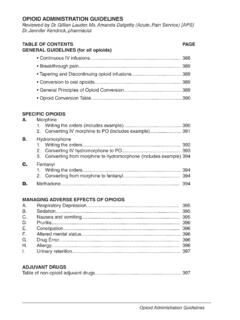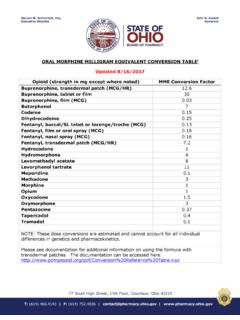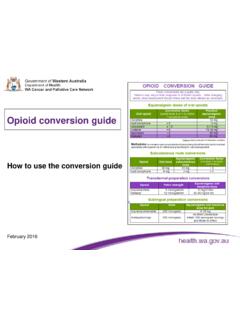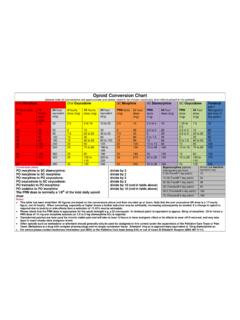Transcription of Opioid Infusion Guidelines for Palliative Care
1 1 Opioid Infusion Guidelines for Palliative CareLeslie N. Schechter, Pharmacy SpecialistBarbara Lineham, RN, MSNM edical/Pain Clinical Nurse SpecialistThomas Jefferson University HospitalPhiladelphia, PennsylvaniaGoal of Opioid Infusion GuidelinesEstablish a step by step approach to rational Opioid Infusion prescribingRecognize that an order to start a Morphine Infusion at 1mg/hour and titrate to effect is pharmacologically unsound and unsafe2 Morphine 1 mg/hr and titrate. Why is this inappropriate?This order places full responsibility for dose titration upon the provides no guidance regarding what dose to titrate or dose titration poses the potential for over dosage by too zealous dose escalationProvides only one option for poorly controlled pain increasing the state drug levels are not being achieved with frequent Infusion rate Dosing Method--ExampleBegin Infusion at 2 mg/hr and give morphine 2 mg q15min for breakthrough pain.
2 If patient requires 2 or more doses per hour, increase Infusion rate according to titration chart (3 mg/hr)3 Why is this preferred?Order provides basal rate and breakthrough breakthrough dose has a peak effect within 10 minutes (effect is quicker)If breakthrough dose is inadequate, another dose may be of basal rate is based on the need for breakthrough pain dosesTJUH Opioid Infusion Guidelines for Palliative CareThese Guidelines are for the initiation and titration of continuous Opioid infusions with the goal of controlling symptoms in patients experiencing pain and/or dyspnea associated with terminal illness.
3 The intent of therapy is to relieve intractable suffering, not hasten Opioid Infusion Guidelines for Palliative CareOpioid na ve patientzStart Infusion at 1 mg/hrzWith initiation of therapy, a bolus dose of 2 mg is appropriatezIf a patient requires 2 or more bolus doses in an hour, the Infusion rate should be increased to the next rate according to the titration na ve patientAn increase should not occur more frequently than once per time the basal Infusion is increased, the bolus dose may need to be increased. Once the patient s symptoms have been controlled.
4 Maintain the current effective Infusion Na ve Patient--Morphine10 mg every 15 minutes40 mg/hr10 mg every 15 minutes32 mg/hr10 mg every 15 minutes26 mg/hr10 mg every 15 minutes20 mg/hr6 mg every 15 minutes16 mg/hr6 mg every 15 minutes12 mg/hr4 mg every 15 minutes8 mg/hr3 mg every 15 minutes5 mg/hr2 mg every 15 minutes3 mg/hr2 mg every 15 minutes2 mg/hr2 mg every 15 minutes1 mg/hrPRN Bolus DosesInfusion RateOpioid Na ve HydromorphoneInfusion RatePRN Bolus mg every 15 mg every 15 every 15 minutes1 mg every 15 mg every 15 mg every 15 mg every 15 minutes4 mg/hr2 mg every 15 mg/hr2 mg every 15 mg/hr2 mg every 15 minutes8 mg/hr2 mg every 15 minutes5 Opioid Na ve FentynlInfusion RatePRN Bolus Doses10 mcg/hr20 mcg every 15 minutes20 mcg/hr20 mcg every 15 minutes30 mcg/hr20 mcg every 15 minutes50 mcg/hr30 mcg every 15 minutes80 mcg/hr40 mcg every 15 minutes120 mcg/hr60 mcg every 15 minutes160 mcg/hr60 mcg every 15 minutes200 mcg/hr100 mcg every 15 minutes260 mcg/hr100 mcg every 15 minutes320 mcg/hr100 mcg every 15 minutes400 mcg/hr100 mcg every 15
5 MinutesWhy were these doses selected?Basal Infusion ratezGoing from 1 to 2mg/hr is a 100% increasezGoing from 10 to 11 mg/hr is a 10% increasezDoses are usually increased by 25 to 100% depending on the severity of the were these doses selected?Breakthrough pain doseszPatient receiving 2 mg/hr receives 2 mg bolus (100%).zIf patient is receiving 20 mg/hr and the bolus dose remained at 2 mg, bolus dose is only 10% of basal. Patient will not receive relief from bolus if not 25 to 100% of Tolerant PatientMD calculates the 24 hour dose of the currently used Opioid ( conversion table)
6 Convert to an equianalgesic dose IV morphine and divide by 24 to calculate starting hourly the patient requires 2 or more boluses in an hour, the Infusion rate should be increased to the next Infusion rate on the titration Tolerant PatientDo not increase basal rate more than once an time the basal Infusion is increased, the bolus dose may need to be the patient s symptoms have been controlled, maintain the current effective basal Infusion Tolerant -Morphine20 mg every 15 minutes40 mg/hr20 mg every 15 minutes32 mg/hr15 mg every 15 minutes26 mg/hr10 mg every 15 minutes20 mg/hr8 mg every 15 minutes16 mg/hr8 mg every 15 minutes12 mg/hr4 mg every 15 minutes8 mg/hr4 mg every 15 minutes5 mg/hr2 mg every 15 minutes3 mg/hr2 mg every 15 minutes2 mg/hr2 mg every 15 minutes1 mg/hrPRN Bolus DosesInfusion Rate7 Opioid Tolerant HydromorphoneInfusion RatePRN Bolus mg every 15 mg every 15 mg every 15 minutes1 mg every 15 mg
7 Every 15 mg every 15 mg every 15 minutes4 mg/hr2 mg every 15 mg/hr3 mg every 15 mg/hr4 mg every 15 minutes8 mg/hr4 mg every 15 minutesOpioid Tolerant FentynlInfusion RatePRN Bolus Doses10 mcg/hr20 mcg every 15 minutes20 mcg/hr20 mcg every 15 minutes30 mcg/hr20 mcg every 15 minutes50 mcg/hr40 mg every 15 minutes80 mcg/hr40 mcg every 15 minutes120 mcg/hr80 mcg every 15 minutes160 mcg/hr80 mcg every 15 minutes200 mcg/hr100 mcg every 15 minutes260 mcg/hr150 mcg every 15 minutes320 mcg/hr200 mcg every 15 minutes400 mcg/hr200 mcg every 15 minutesInfusion RatePRN bolus doses40 mg/hr20 mg every 15 minutes50 mg/hr20 mg every 15 minutes60 mg/hr25 mg every 15 minutes75 mg/hr30 mg every 15 minutes90 mg/hr30 mg every 15 minutes110 mg/hr40 mg every 15 minutes135 mg/hr40 mg every 15 minutes165 mg/hr50 mg every 15 minutes200 mg/hr50 mg every 15 minutes240 mg/hr50 mg every 15 minutes280 mg/hr80 mg every 15 minutes340 mg/hr80 mg every 15 minutes400 mg/hr80 mg every 15 minutesOpioid Palliative care Protocol Morphine >40mg/hr8 Infusion RatePRN bolus doses8 mg/hr4 mg every 15
8 Minutes10 mg/hr4 mg every 15 minutes12 mg/hr5 mg every 15 minutes15 mg/hr6 mg every 15 minutes18 mg/hr6 mg every 15 minutes22 mg/hr8 mg every 15 minutes27 mg/hr8 mg every 15 minutes33 mg/hr10 mg every 15 minutes40 mg/hr10 mg every 15 minutes48 mg/hr10 mg every 15 minutes56 mg/hr16 mg every 15 minutes68 mg/hr16 mg every 15 minutes80 mg/hr16 mg every 15 minutesOpioid Tolerant Palliative care Infusion requiring doses of Hydromorphone >8mg/hrInfusion RatePRN bolus doses400 mcg/hr200 mcg every 15 minutes500 mcg/hr200 mcg every 15 minutes600 mcg/hr250 mcg every 15 minutes750 mcg/hr300 mcg every 15 minutes900 mcg/hr300 mcg every 15 minutes1100 mcg/hr ( mg/hr)400 mcg every 15 minutes1350 mcg/hr ( mg/hr)400 mcg every 15 minutes1650 mcg/hr ( mg/hr)500 mcg every 15 minutes2000 mcg/hr (2 mg/hr)500 mcg every 15 minutes2400 mcg/hr ( mg/hr)500 mcg every 15 minutes2800 mcg/hr ( mg/hr)800 mcg every 15 minutes3400 mcg/hr ( mg/hr)800 mcg every 15 minutes4000 mcg/hr (4 mg/hr)
9 800 mcg every 15 minutesFentanyl Infusion for Palliative care Opioid tolerant patient requiring doses > 400mcg/hrPatient MonitoringMD will have a choice of monitoringzPain ScalezNumeric Pain ScalezWong-Baker Faces ScalezChecklist of Nonverbal Pain Indicator (CNPI) ScalezDyspnea Evaluation9 CNPI-Checklist of Nonverbal Pain IndicatorsThe instructions for use of the Non-Verbal Pain Indicators (CNPI) Use this assessment tool a) only for adults and b) ONLY if the adult patient cannot self-report his/her pain. Discuss the patient s individualized signs of pain with the patient s family/significant other For patients who are monitored, you may also assess vital signs.
10 Note: B/P, pulse, respiratory rate, pulse oximetry, For sedated/paralyzed patients on a ventilator, consider lightening up the sedation/paralytics once/day (check with physician) to assess pain. Adjust analgesics when necessary. Terminal patients are exempt from this. Consider medicating the patient with analgesic if the pain score is greater >then the midpoint of subtotalscore or totalscore. The interpretation is as follows 1-2 mild pain, 3-4 moderate pain, 5-6 severe pain. If you suspect a patient is in pain (even if the score is not > the midpoint of a subtotal or total score), obtain a score, medicate if appropriate & re-score (re-assess) the pa


